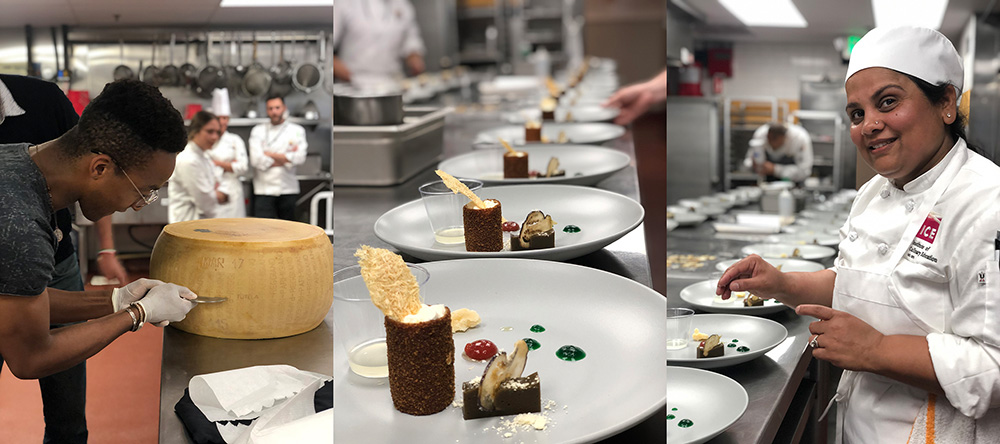Parmigiano-Reggiano is as much a simple pasta garnish as it is a versatile, primary ingredient, and it has a rich heritage that’s still evolving today.
The prized hard cheese had a moment in 2012, when an earthquake rattled Italy’s Emilia-Romagna region and threatened its cheese industry. Chef Massimo Bottura, of Michelin-starred Osteria Francescana, incorporated Parmigiano-Reggiano in a risotto cacio e pepe that spurred a movement to utilize the more than 1,000 damaged wheels of the prized cheese with a fresh perspective on its applications.
Parmigiano-Reggiano has been reimagined in dishes by chefs around the world since — including at ICE’s Los Angeles campus, where Culinary Arts Lead Chef Daniel Rossi re-fashioned the traditional eggplant parmesan into a modern iteration with Parmigiano broth, espuma, foam, frico and EVOO soil for a recent seminar where Federico Bolla, co-director of the Consorzio Parmigiano-Reggiano USA, shared his expertise on the ingredient’s versatility in dishes, what makes the famous cheese unique, and how to properly crack open a wheel and determine its authenticity.
During the event, Federico explained that this ubiquitous cheese is quite simply named after the area in Italy where it’s produced. Parmigiano means “from Parma” and Reggiano, “from Reggio Emilia.” As with wine, terroir plays a key factor in the final product. The meadows in the Po Valley are bordered by a mountain range and two rivers. Four cow breeds graze on this biodiverse land where more than 60 herb varieties grow, impacting the milk’s flavors and aromas.

“This was one of the first cheeses in Italy to be a PDO (Protected Designation of Origin) cheese,” says ICE alum and cheese expert Brianna Giannizzero (Management, ‘17). “Strict rules and regulations must be followed when producing this cheese. Where the cows graze, what they graze on and where the cheeses are aged are all factors that are regulated by the Italian government.”
Parmigiano-Reggiano is made with only three ingredients: cow’s milk, rennet and salt. Inside copper vats, curds are broken into fine grains using a tool called a spino. Those grains settle into the bottom of the vat.
“Curd size determines how much moisture a cheese will have,” Brianna explains. “Parmigiano-Reggiano is extremely low-moisture, so those curds are broken into roughly rice-size pieces where they are pressed and then aged. Milk is full of proteins, which will eventually turn into amino acid complexes if you allow them to age for long enough. Most parm is aged for 16-36 months, allowing this cheese to turn into beautiful caramelly and crystallized goodness.”
Each year, 300 dairy farms in the area produce the more than 10,000 wheels, which travel to destinations around the globe after aging. To deduce if a wedge of Parmigiano is authentic, Federico warned to be weary of the packaging: A colorful Italian flag does not indicate that a cheese is from the area. There are specific cues that determine quality and authenticity.
“The authenticity of a wheel of Parmigiano-Reggiano or a wedge is determined by looking at the rind,” Federico explained. “First, notice if pin-dotted markings spell "Parmigiano-Reggiano.” The wheel will be marked with three to four digits, which identify the dairy farm where it was produced, and the month and year of the production date are stamped on the wheel.
“The months are written in Italian, so Lug stands for Luglio or July in English,” he said. “If you see Lug 17 it means that wheel was produced in July 2017 and today it would be a 24 months aged cheese.” If you don’t have an entire wheel to examine, Bolla suggests talking to the cheesemonger. “You'll have to ask whomever is selling it to you and hopefully they will be honest about the age.”
ICE students had the opportunity to crack open the hefty wheel, a skill that takes practice. Federico advised that the wheel should be left out at room temperature and wiped down with paper towels or a clean towel to ensure it is not too greasy to handle. Chefs should examine the condition of the rind, looking for cuts or deep cracks, and then use a sturdy surface and place the wheel at an angle to properly apply pressure.
Specialty Parmigiano cheese knives are recommended when cutting open a wheel: the hook knife to score a line around the diameter of the wheel, between the words “Parmigiano” and “Reggiano,” and a serrated knife to follow that line, sinking in and applying pressure. Repeat with the parmesan knife. Keep going, alternating until you’ve followed the entire way around the wheel. At this point, a crack should be evident. Insert a longer spatula knife with some pressure around the crack, and the two halves should come apart and open the wheel like a treasure chest.
“Parmigiano-Reggiano is my ideal umami bomb,” Brianna says. “It’s rich yet fruity and salty yet still has deep caramel notes. There certainly is some sort of beautiful cultural phenomenon behind it.”
Federico pointed out that it’s a zero-waste cheese: The rind can be used to flavor soups, sauces and broths. Be inventive, like chefs Daniel and Massimo, to reimagine cooking with this classic.
Explore more authentic ingredients at ICE's Los Angeles campus.




